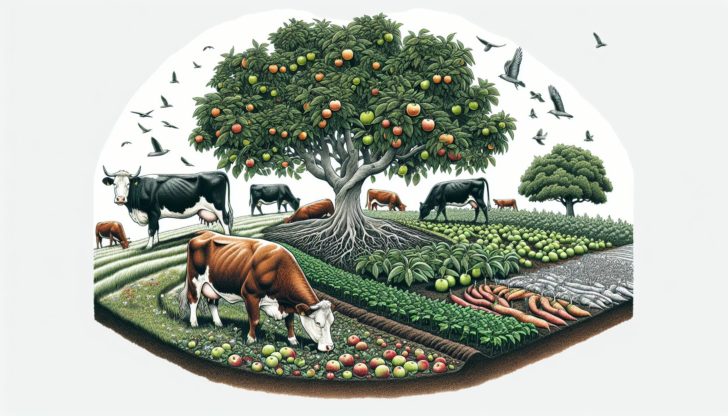Regenerative agriculture is redefining our approach to farming by rebuilding soil health and ecosystem diversity. It’s not just about growing crops; it’s a mission to heal our land and mitigate climate change. From soil regeneration and increased biodiversity to carbon sequestration, this guide unpacks the why and how of regenerative agriculture’s essential practices, distinct from conventional methods, and its potential to reshape our agricultural landscape.
Table of Contents
Key Takeaways
Regenerative agriculture prioritizes long-term soil health, biodiversity, and ecosystem restoration, offering a holistic approach to sustainable farming that contrasts with conventional agricultural practices focusing on short-term yields.
Key practices of regenerative agriculture include no-till farming, cover crops, crop rotation, and integrating livestock, all contributing to soil preservation, water management, and reduced synthetic input needs while combating climate change by sequestering carbon.
Although demonstrating economic and socially equitable benefits, regenerative agriculture faces challenges such as high transition costs, lack of access to resources for small-scale farmers, market barriers, and a need for greater education and policy support.
Understanding Regenerative Agriculture

Regenerative organic agriculture is a systems-based approach to farming that puts soil health at the forefront, aiming to restore ecosystems, and work in harmony with nature. Unlike conventional farming, which often focuses on short-term crop yields, regenerative agriculture is about enhancing the land’s health through holistic land stewardship. It focuses on making improvements to soil health and the overall quality and health of the land, recognizing the interconnectedness of soil, water, air, plants, animals, and people.
Regenerative farming is not a one-size-fits-all approach; it’s adaptable and takes into consideration the unique context of each farmer, including climate, geography, resources, and goals. Education about regenerative agriculture is crucial for understanding its principles, recognizing the sun’s role in energy flow, and making informed decisions to support sustainable agricultural practices.
The philosophy behind regenerative agriculture
The philosophy of regenerative agriculture is rooted in a mindset that emphasizes:
the management of land and sustainability
practices that enhance soil health
increasing biodiversity
producing food and other products in a sustainable and ethical manner
The philosophy behind regenerative agriculture extends beyond the farm and into the community, promoting equitable relationships among all stakeholders, from farmers to consumers.
Regenerative agriculture practices are adaptable and can be applied in various contexts, from large-scale farming operations to small family farms. The focus is on working with nature, rather than against it. For instance, instead of using synthetic fertilizers, regenerative farmers might use compost, cover crops, and animal manures to improve soil fertility. Instead of relying on pesticides, they might use natural predators to control pests.
The role of regenerative agriculture in combating climate change
Regenerative agriculture has an essential role to play in combating climate change. Here are some ways in which it can help:
Healthy soil acts as a carbon pool, absorbing greenhouse gases from the atmosphere through a process wherein plants transfer carbon to the soil.
Practices such as no-till farming prevent the release of carbon dioxide.
Integrating trees into agricultural systems enhances carbon sequestration.
Scaling up regenerative agriculture could potentially:
Reduce emissions by approximately 600 million tons, equivalent to the national footprint of Germany
Increase the resilience of farming systems to climate-related disruptions
Contribute to the overall decarbonization of the food system
Thus, regenerative agriculture offers a double win for our planet, enhancing farm productivity while mitigating climate change impacts.
Key Components of Regenerative Agriculture

The holistic approach of regenerative agriculture encompasses several key components, including soil health, water management, and erosion control among other factors. A key principle of regenerative agriculture is minimum soil disturbance. This is achieved through practices that protect the natural soil structure and its microbial life, such as no-till farming or conservation tillage. Effective water cycling is another critical aspect of regenerative agriculture, ensuring improved water management in the ecosystem.
Covering the soil plays a crucial role in regenerative farming. It can be achieved through different practices like planting cover crops, using crop residue, or dedicated grazing plants. Such practices help maintain a healthy soil ecosystem. Moreover, continuous living plant roots are significant for keeping soil biology active and feeding beneficial microbes, thus maintaining the vitality of the soil. At the same time, achieving an herbicide-free farm can lead to increased crop yields, cost savings, and reduced labor intensity, contributing to the overall economic sustainability of the farm.
Employing a holistic approach to manage weeds underpins the health improvement of the land in regenerative agricultural systems.
Soil health and organic matter
In regenerative agriculture, soil health is paramount. It’s viewed as essential to producing robust and profitable crops and supporting the farm ecosystem through nature-based solutions. Increased soil organic matter is pivotal in regenerative agriculture for enhancing the growth of crops and livestock, which form the economic base for farmers, while also enabling ecosystems to function optimally.
Improvements in soil health can be achieved through various practices such as planting cover crops, which ultimately improve soil health. These practices enhance soil structure, nutrient availability, water retention, and carbon sequestration, along with boosting biodiversity. The health of soil in regenerative systems is characterized by organic matter content, living organisms activity, and adherence to the six principles of soil health which guide healthier land management.
Biodiversity and ecosystem preservation
Preserving biodiversity is integral to regenerative agriculture. Moving away from monocultures is beneficial for wildlife habitat and ecosystem health, mimicking nature’s diversity and ecosystem performance. Implementing multi-species cover crops as part of regenerative farming practices enhances soil microbiome diversity and supports biodiversity.
Agroforestry, which includes the integration of trees into farming systems, contributes to biodiversity conservation by providing diverse habitats for birds, insects, and other beneficial organisms. Farmers and ranchers practicing regenerative agriculture report an increase in the number and variety of species on their land, indicating a positive impact on biodiversity.
Reducing synthetic inputs and promoting natural systems
One of the cornerstones of regenerative agriculture is the reduction of synthetic inputs like herbicides, pesticides, and artificial fertilizers. By minimizing reliance on synthetic fertilizers and pesticides, production costs for farming are lowered. Lowered production costs due to reduced synthetic input use lead to improved profitability for farmers engaging in regenerative agriculture practices.
This not only contributes to environmental health by reducing chemical runoff into our waterways, but also to the health of consumers who enjoy food products free of chemical residues.
Implementing Regenerative Agriculture Practices

Implementing regenerative agriculture practices involves a significant shift from conventional farming methods. Conventional farming, particularly in large-scale monocultures, relies heavily on synthetic inputs which can be detrimental to long-term soil health.
On the other hand, utilizing regenerative agricultural techniques leads to a decrease in soil erosion and water pollution due to the lowered dependency on chemical inputs.
No-till farming and conservation tillage
No-till farming is one of the key practices in regenerative agriculture. It involves:
planting seeds directly into undisturbed soil, thereby preserving moisture and minimizing soil disturbance
leaving crop residue on the field, reducing evaporation and conserving soil moisture
contributing to preserving the soil structure
Continual no-till farming offers several benefits, including:
Enhanced soil aeration and fertility through the proliferation of soil organisms
Prevention of topsoil erosion
Reduction of water pollution by keeping fertilizers and herbicides from washing into water bodies
Effective management of soil fertility
Control of weed, pest, and disease pressures
These benefits make no-till farming a sustainable and environmentally-friendly farming practice.
Crop rotation and cover crops
Crop rotation and cover crops are other significant aspects of regenerative agriculture. Implementing crop rotation and growing cover crops contribute to soil fertility. These practices also suppress weeds and break pest and disease cycles, leading to healthier and more productive crops.
Additionally, incorporating green manure, the biomass from cover crops, into the soil before planting cash crops can significantly boost yields. These practices show how regenerative agriculture uses nature’s own mechanisms to improve crop health and yield while maintaining the health of the soil and surrounding ecosystems.
Integrating livestock and agroforestry
The integration of livestock and agroforestry into farming systems is another key feature of regenerative agriculture. Livestock are integral for stimulating the carbon sequestration process in regenerative agriculture through appropriately managed grazing. Grass is identified as the least costly feed for cows, indicating a preference for natural grazing over reliance on hay and processed feed.
Incorporating livestock into regenerative agriculture systems contributes benefits such as natural fertilization, soil aeration, increased organic matter, and improved resistance to erosion. Additionally, effective grazing practices enhance soil and plant health by recycling nutrients, encouraging even grazing, and fostering plant diversity. It’s clear from these practices that regenerative agriculture promotes natural nutrient cycles and reduces the reliance on chemical pest controls through the strategic integration of livestock with crops and land.
Social and Economic Aspects of Regenerative Agriculture
Regenerative agriculture is not just about farm productivity and environmental sustainability. It also addresses social inequities and promotes economic sustainability. Higher yields generally lead to higher incomes on certified farms, and certified crops often fetch higher market prices, which enhances economic sustainability for farmers practicing regenerative agriculture.
However, to scale regenerative agriculture, it is crucial to ensure that regenerative farming practices are commercially viable for farmers. At the same time, regenerative agriculture promotes social equity by including gender equity, giving women access to resources, training, and participation in decision-making processes.
Moreover, community engagement in regenerative agriculture, supported by organizations like the Rainforest Alliance, fosters a strong sense of ownership and active participation, leading to improved farm management and business practices, ultimately enhancing household incomes.
Addressing social inequities in agriculture
Regenerative agriculture has roots that counteract historical agricultural practices that often marginalized indigenous peoples and local communities. Minorities and disadvantaged groups have historically experienced systemic discrimination in agriculture, including unequal access to agricultural land and resources. Disadvantaged groups often face challenges in obtaining agricultural financing, contributing to a cycle of limited access to capital and resources.
Access to land is a crucial factor for farm viability, yet has often been out of reach for many marginalized farmers. Credit access is critical for farmers to invest in sustainable practices, and credit discrimination has been a significant barrier for minority farmers. Educational opportunities in regenerative methods can lead to more inclusive agricultural communities by empowering marginalized farmers with knowledge and skills.
Some key factors for promoting inclusivity in agriculture are:
Increasing access to land for marginalized farmers
Addressing credit discrimination and providing financial support for sustainable practices
Offering educational opportunities in regenerative methods
By focusing on these factors, we can work towards creating a more inclusive and sustainable agricultural system, promoting sustainable agriculture in the agricultural sector.
Adopting regenerative agriculture practices can help address social inequities by empowering farmers through improved land stewardship and equitable resource distribution.
Economic benefits and profitability
The economic benefits of regenerative agriculture are significant and multi-faceted. Regenerative agriculture practices such as no-till farming contribute to a significant decrease in costs for fuel, labor, and machinery, leading to increased profitability for farmers. Farmers implementing regenerative agriculture practices typically see improved livelihoods due to cost reductions and enhancements in crop yield and quality.
Through agroforestry, farmers can diversify their sources of income by integrating tree crops, cash crops, and livestock, which provides economic and social benefits. New revenue streams, such as compensation for carbon sequestration in soil, are made available to farmers transitioning to regenerative agriculture. Furthermore, regenerative ranching practices result in positive outcomes for animal health, quality of life for people, and the overall environmental quality, contributing to an improved bottom line.
Case Studies: Success Stories in Regenerative Agriculture

Now, let’s bring the concept of regenerative agriculture to life with real-world examples. The Balbo Group in Brazil, for instance, achieved a 20% increase in sugarcane production compared to conventional methods by implementing regenerative agriculture techniques. In France, Bec-Hellouin demonstrated high productivity in a forest garden with 800 plant varieties based on permaculture principles.
Ridgedale Farm in Sweden showcases the viability of combining crop and livestock operations with education in regenerative agriculture, despite its limited frost-free days. In the Juaboso-Bia region of Ghana, the introduction of regenerative practices like planting native trees along riverbanks and employing soil and water conservation techniques helped prevent the drying up of a vital river. These success stories highlight the adaptability and effectiveness of regenerative agriculture in various contexts.
Challenges and Obstacles in Adopting Regenerative Agriculture
While regenerative agriculture holds great promise, it is not without its challenges. A significant obstacle to scaling regenerative agriculture is the initial cost and risk of transition, which currently falls heavily on farmers, particularly small-scale ones. Accessing necessary inputs like organic seeds and technologies for regenerative agriculture can be difficult in regions predominantly practicing conventional agriculture.
Moreover, products of regenerative agriculture might struggle to enter mainstream markets, affected by consumer preferences and established supply chains in food production. Farmers and stakeholders may also be unaware of regenerative practices and their benefits, indicating a need for educational programs and knowledge-sharing networks.
Lastly, farmers may perceive risks and uncertainties with adopting regenerative practices, such as yield reductions or unfamiliar methods.
How You Can Support Regenerative Agriculture
Supporting regenerative agriculture goes beyond the farming community. Here are some ways to support regenerative agriculture:
Provide financial aid such as grants, subsidies, and low-interest loans to help farmers make the transition to regenerative agriculture.
Offer technical support to farmers to help them implement regenerative practices.
Implement policy frameworks and incentive programs that recognize and reward regenerative practices, encouraging more farmers to adopt them.
Secure land tenure rights for sustained practice of regenerative agriculture.
As consumers, we can support regenerative agriculture by choosing to buy products from local farmers who utilize regenerative farming methods. Contributions can also be made to the advancement of regenerative agriculture by donating to or volunteering with organizations that work to promote sustainable farming systems. Establishing farmer-to-farmer networks enables the sharing of knowledge and best practices about regenerative techniques, fostering a community-based approach to agricultural sustainability.
Starting a regenerative garden helps individuals understand regenerative agriculture principles firsthand and contributes to local biodiversity and ecosystem health. Finally, educating friends, family, and the broader community about the benefits and practices of regenerative agriculture can help increase awareness and support for the movement.
Learn more, visit 5 Ways You Can Support Regenerative Agriculture to Help Heal the Planet.
Summary
In conclusion, regenerative agriculture offers a holistic approach to farming that not only boosts productivity but also revitalizes ecosystems, addresses social inequities, and promotes economic sustainability. While there are challenges to adopting regenerative agriculture, its multitude of benefits, as demonstrated by the success stories across the globe, make it an essential shift in our agricultural paradigm. As consumers, we can play a crucial role in supporting regenerative agriculture through our purchasing choices and advocacy. Let’s move toward an agricultural future that works in harmony with nature, rather than against it.
Frequently Asked Questions
What is the philosophy behind regenerative agriculture?
The philosophy behind regenerative agriculture focuses on land management and sustainability, promoting practices that enhance soil health, biodiversity, and ethical food production.
How does regenerative agriculture help combat climate change?
Regenerative agriculture helps combat climate change by sequestering carbon, enhancing resilience, and reducing emissions in the agricultural sector, making farming systems more resilient to climate-related disruptions.
What are some of the key practices in regenerative agriculture?
Some key practices in regenerative agriculture include no-till farming, crop rotation, use of cover crops, and integration of livestock and agroforestry into farming systems. These methods help improve soil health and promote sustainable farming.
How does regenerative agriculture address social inequities in farming?
Regenerative agriculture addresses social inequities in farming by empowering disadvantaged farmers with improved land stewardship, equitable resource distribution, and access to education in regenerative methods. This can help bridge the gap in farming opportunities and resources for marginalized communities.
How can I support regenerative agriculture as a consumer?
To support regenerative agriculture as a consumer, you can buy products from local farmers practicing regenerative farming methods and contribute to organizations promoting sustainable farming. This will help promote and sustain regenerative agricultural practices in your community.









